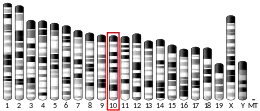STXBP5
Syntaxin-binding protein 5 is a protein that in humans is encoded by the STXBP5 gene. It is also known as tomosyn, after 友, "friend" in Japanese, for its role as a binding protein.[5][6][7]
Function
Syntaxin 1 is a component of the 7S and 20S SNARE complexes which are involved in docking and fusion of synaptic vesicles with the presynaptic plasma membrane. This gene encodes a syntaxin 1 binding protein. In rat, a similar protein dissociates syntaxin 1 from the Munc18/n-Sec1/rbSec1 complex to form a 10S complex, an intermediate which can be converted to the 7S SNARE complex. Thus this protein is thought to be involved in neurotransmitter release by stimulating SNARE complex formation. Alternatively spliced variants have been identified, but their biological validity has not been determined.[7]
Positional cloning suggested that tomosyn might inhibit neurotransmitter secretion in Caenorhabditis elegans neurons.][8] This hypothesis was tested and confirmed, showing that tomosyn specifically inhibits synaptic vesicle priming—the biochemical step immediately preceding vesicle fusion and neurotransmitter release.[9]
Structure
Two functional domains were originally identified, including one which binds to syntaxin, but recent crystallization of the yeast homolog Sro7 revealed that tomosyn likely has three functional domains: one WD40 domain and one syntaxin-binding domain, as previously recognized, but also another WD40 domain. The study also suggested that tomosyn's 'syntaxin binding domain' is not the reason tomosyn is inhibitory for neurotransmitter release, as originally proposed.[10] The Sro7-based structure is currently given on SWISS-MODEL, which includes the WD40 domains but not most of the coiled coil syntaxin-binding domain seen in the infobox.[11]
References
- GRCh38: Ensembl release 89: ENSG00000164506 - Ensembl, May 2017
- GRCm38: Ensembl release 89: ENSMUSG00000019790 - Ensembl, May 2017
- "Human PubMed Reference:". National Center for Biotechnology Information, U.S. National Library of Medicine.
- "Mouse PubMed Reference:". National Center for Biotechnology Information, U.S. National Library of Medicine.
- Fujita Y, Shirataki H, Sakisaka T, Asakura T, Ohya T, Kotani H, Yokoyama S, Nishioka H, Matsuura Y, Mizoguchi A, Scheller RH, Takai Y (Jun 1998). "Tomosyn: a syntaxin-1-binding protein that forms a novel complex in the neurotransmitter release process". Neuron. 20 (5): 905–15. doi:10.1016/S0896-6273(00)80472-9. PMID 9620695. S2CID 12597505.
- Katoh M, Katoh M (Feb 2004). "Identification and characterization of human LLGL4 gene and mouse Llgl4 gene in silico". Int. J. Oncol. 24 (3): 737–42. doi:10.3892/ijo.24.3.737. PMID 14767561.
- "Entrez Gene: STXBP5 syntaxin binding protein 5 (tomosyn)".
- Dybbs M, Ngai J, Kaplan JM (July 2005). "Using microarrays to facilitate positional cloning: identification of tomosyn as an inhibitor of neurosecretion". PLOS Genet. 1 (1): 6–16. doi:10.1371/journal.pgen.0010002. PMC 1183521. PMID 16103915.

- Gracheva EO, Burdina AO, Holgado AM, et al. (July 2006). "Tomosyn inhibits synaptic vesicle priming in Caenorhabditis elegans". PLOS Biol. 4 (8): e261. doi:10.1371/journal.pbio.0040261. PMC 1514790. PMID 16895441.

- Hattendorf DA, Andreeva A, Gangar A, Brennwald PJ, Weis WI (March 2007). "Structure of the yeast polarity protein Sro7 reveals a SNARE regulatory mechanism". Nature. 446 (7135): 567–71. Bibcode:2007Natur.446..567H. doi:10.1038/nature05635. PMID 17392788. S2CID 4399611.
- "Q5T5C0". SWISS-MODEL Repository.
- Widberg CH, Bryant NJ, Girotti M, Rea S, James DE (Sep 2003). "Tomosyn interacts with the t-SNAREs syntaxin4 and SNAP23 and plays a role in insulin-stimulated GLUT4 translocation". J. Biol. Chem. 278 (37): 35093–101. doi:10.1074/jbc.M304261200. PMID 12832401.
Further reading
- Olsen JV, Blagoev B, Gnad F, Macek B, Kumar C, Mortensen P, Mann M (2006). "Global, in vivo, and site-specific phosphorylation dynamics in signaling networks". Cell. 127 (3): 635–48. doi:10.1016/j.cell.2006.09.026. PMID 17081983. S2CID 7827573.
- Widberg CH, Bryant NJ, Girotti M, Rea S, James DE (2003). "Tomosyn interacts with the t-SNAREs syntaxin4 and SNAP23 and plays a role in insulin-stimulated GLUT4 translocation". J. Biol. Chem. 278 (37): 35093–101. doi:10.1074/jbc.M304261200. PMID 12832401.
- Yokoyama S, Shirataki H, Sakisaka T, Takai Y (1999). "Three splicing variants of tomosyn and identification of their syntaxin-binding region". Biochem. Biophys. Res. Commun. 256 (1): 218–22. doi:10.1006/bbrc.1999.0300. PMID 10066450.





